Wearing a beret and tired eyes, Kamba tiptoes between sprawled, sleeping demonstrators and discussion circles in the middle of Tahrir Square's tent city. He chooses a seemingly random discussion circle and kneels next to Ahmed, a 23-year-old agricultural engineering student.
Holding a timetable, Kamba points to Ahmed’s name, where the times 2 – 5 am are written. “Did you head out to your shift yet?” he asks, interrupting Ahmed's conversation.
It’s 2:15 am, and Ahmed doesn’t want to leave his conversation, but after all, he did volunteer.
Kamba (he identifies himself only by his first name) handles security at one of the entrances to Tahrir Square. He and some friends have taken it upon themselves to gather volunteers for gate duty, especially from the perennially deliberative “activist” tents that now surround him. “Did you turn yourself in?” is what he usually asks upon seeing a new face.
After thousands flocked to Tahrir on 8 July to renew their protest to fulfill the revolution's demands, a smaller number has remained behind, holding an open-ended sit-in that still awaits what they hope will be a concessional response from the government. For the past two weeks, Tahrir has operated yet again as an autonomous enclave, containing some permanent dwellers who have figured out their own system of self-management and preservation.
The first 18-day sit-in was a bold display of defiance, and brought numbers in the hundreds of thousands. The numbers are smaller this time, creating an increased need for a better organized sit-in.
“Now, we have to be more focused in Tahrir. We can manage ourselves here, while organizing for the revolution,” says Essam Abdel Halim, a 28 year-old accountant who spends his nights in Tahrir and mornings at work.
Other popular committees guard the entrances to Tahrir in the same way as Kamba’s group. The April 6 Youth Movement has staked their claim to one entrance, and other groups of young men and women have randomly gathered to form other entrance committees. In general, though, each group acts independently.
While some in the square see this decentralization as one of the main benefits of the Tahrir sit-in, others consider it to be a problem.
“[The decentralization] makes it easier for ill-willed individuals to form groups and cause disturbances in the square,” says Ibrahim Hassan, who’s been at the sit-in for six days.
The Coalition of Independent Youth is one group many consider to be problematic. They formed mainly during the current sit-in, and were at the epicenter at some of the more controversial moments in the square.
Marawan Abdallah, a member of the group, takes it upon himself to conduct security checks on many of the tents to look for weapons and “ethical” infringements. “We’ve found many tents with knives and clubs, and others meant for drugs and sex,” he says.
Abdallah and his peers' inspection activities have already caused altercations, as well as provoked some of the existing activist groups.
“These other groups here (like the 25 January Revolution Youth Coalition) speak for us, yet aren’t a part of us and some get foreign funding. They offered me LE32,000 to leave Tahrir,” he claims.
Many in the square also blamed the Coalition of Independent Youth for instigating the fights with Tahrir’s street vendors.
Mohamed Emad believes that these disputes represent the perils inherent in a protracted sit-in.
“In this sit-in, the disunity makes it easier for disagreements to start. The solution is higher participation and more interaction between the groups,” says the 35-year-old Suez native and tour guide, who has camped out at Tahrir since 1 July.
At night, the square tends to come alive with debate, often discussing how to best escalate the revolution and unify its demands. But the debates mostly take place within disparate groups.
Lately, however, some peripatetic demonstrators have attempted to engage in consensus-building exercises.
“I feel like the revolution is slipping from our hands,” worries Samar Thawrat, 24.
Thawrat, who is entering her last semester as a student at Cairo University's faculty of arts, has spent a few nights jotting down common demands from different tents and groups in an attempt to create a unified system of issuing demands and determine the sit-in’s future viability.
“It is not very encouraging, as some of the groups I was really looking forward to including in [my collective report] don’t believe in it,” she says.
However, some do not believe that the sit-in requires political consensus or security coordination.
“The beauty of the square is that everyone is doing what they would like to do on their own. It will all come together, because we know – despite our differences – that we want to be here until the revolution has succeeded in real change,” says Bassem Hassan, 23, who describes himself as a permanent Tahrir resident and member of the 25 January Revolution Youth Coalition.
According to Bassem, the demands are known – he gave a loose list that included trials for killers of martyrs and the end of military trials for civilians – and the revolution will decide its own course.
Despite reports of waning public support for the current sit-in, Bassem does not seem concerned.
“You can blame the media for that,” he says. “But either way, since when did we wait for public opinion? We know we are on the right side; people usually follow.”




